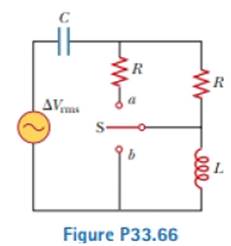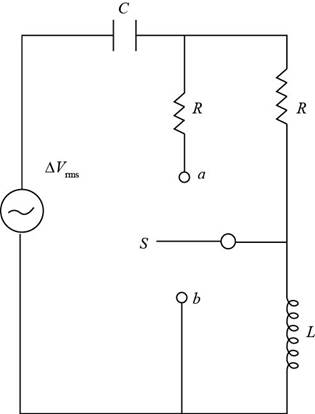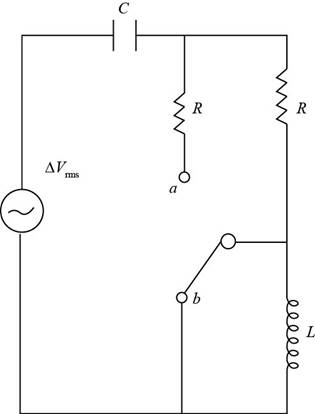
A capacitor, a coil, and two resistors of equal resistance are arranged in an AC circuit as shown in Figure P33.66 (page 1028). An AC source provides an emf of ΔVrms = 20.0 V at a frequency of 60.0 Hz. When the double throw switch S is open as shown in the figure, the rms current is 183 mA. When the switch is closed in position a, the rms current is 298 mA. When the switch is closed in position b, the rms current is 137 mA. Determine the values of (a) R, (b) C, and (c) L. (d) Is more than one set of values possible? Explain.

(a)
The value of resistance.
Answer to Problem 33.66AP
The value of resistance is
Explanation of Solution
Given info: The value of the source emf is
The expression for inductive reactance is,
Here,
The expression for capacitive reactance is,
Here,
The expression for the impedance of the circuit is.
Here,
The expression of the impedance in terms of voltage and current is,
Here,
The figure below depicts the circuit when the switch is in open condition.

Figure (1)
From figure(1), for the throw switch in open condition:
Substitute
Substitute
For the throw switch at a position:
The two resistances are in parallel.
The expression of the equivalent resistance is.
Substitute
Substitute
Subtract equation (2) from equation (1).
Conclusion:
Therefore, the value of resistance is
(b)
The value of the capacitance.
Answer to Problem 33.66AP
The value of the capacitance is
Explanation of Solution
Given info: The value of the source emf is
The figure below depicts the circuit when switch is at position b.

Figure (2)
From figure (2), for the throw switch at b position:
When the switch is at position b the inductor gets short circuited.
Substitute
Rearrange the above expression for value of
Substitute
Substitute
Rearrange the above equation for value of value of
Substitute
Conclusion:
Therefore, the value of the capacitance is
(c)
The value of the inductance.
Answer to Problem 33.66AP
The values of the inductance are
Explanation of Solution
Given info: The value of the source emf is
Substitute
For first value of the inductor,
Substitute
Substitute
Thus, the first value of the inductor is
For second value of the inductor,
Substitute
Substitute  for f in the above expression.
for f in the above expression.
Thus, the second value of the inductor is
Conclusion:
Therefore, the values of the inductance are
(d)
Whether more than one set of value possible.
Answer to Problem 33.66AP
The resistance and capacitance has one set of values, the inductor has in two set of values.
Explanation of Solution
Given info: : The value of the source emf is
From the calculation in part (a),(b) and (c),
The value of resistance is
The value of capacitance is
The values of the inductor are
Hence the resistance and the capacitance has one value while the inductor has two set of value in the circuit.
Conclusion:
Therefore, the resistance and capacitance has one set of values, the inductor has in two set of values.
Want to see more full solutions like this?
Chapter 33 Solutions
Physics for Scientists and Engineers, Technology Update (No access codes included)
- In the AC circuit shown in Figure P32.3, R = 70.0 and the output voltage of the AC source is Vmax sin t. (a) If VR = 0.250 Vmax for the first time at t = 0.0100 s, what is the angular frequency of the source? (b) What is the next value of t for which VR = 0.250 Vmax? Figure P32.6 Problem 3 and 5.arrow_forwardIn a purely inductive AC circuit as shown in Figure P21.15, Vmax = 100. V. (a) The maximum current is 7.50 A at 50.0 Hz. Calculate the inductance L. (b) At what angular frequency is the maximum current 2.50A? Figure p21.15arrow_forwardThe emf of an ac source is given by v(t)=V0sint, where V0=100V and =200 . Find an expression that represents the output current of the source if it is connected across (a) a 20-pF capacitor, (b) a 20-mH inductor, and (c) a 50 resistor.arrow_forward
- In a purely inductive AC circuit as shown in Figure P32.6, Vmax = 100 V. (a) The maximum current is 7.50 A at 50.0 Hz. Calculate the inductance L. (b) What If? At what angular frequency is the maximum current 2.50 A? Figure P32.6 Problem 6 and 7.arrow_forwardA resistor and inductor are connected in series across an ac generator. The emf of the generator is given by v(t)=V0cost , where V0=120V and =120rad/s ; also, R=400 and L = 1.5 H. (a) What Is the impedance of the circuit? (b) What is the amplitude of the current through the resistor? (C) Write an expression for the current through the resistor. (d) Write expressions representing the voltages across the resistor and across the inductor.arrow_forwardA step-down transformer has 65 turns in its primary coil and 10 turns in its secondary coil. The primary coil is connected to standard household voltage (Erms= 120.0 V, 60.0 Hz), a. What is the rms voltage in the secondary coil? b. If, instead, the transformer is connected to a 6-V DC battery, what is the rms voltage in the secondary coil after the first few milliseconds?arrow_forward
- An inductor and a resistor are connected in series across an AC generator, as shown in Figure CQ21.16. Immediately after the switch is closed, which of the following statements is true? (a) The current is V/R. (b) The voltage across the inductor is zero. (c) The current in the circuit is zero. (d) The voltage across the resistor is V. (e) The voltage across the inductor is half its maximum value. Figure CQ21.16arrow_forwardAn AC generator with an rms emf of 15.0 V is connected in series with a 0.54-H inductor. The frequency of the source emf is 70.0 Hz. Draw a phasor diagram for this circuit, including the current, the potential difference across the inductor, and the source emf. Draw your diagram with the current phasor pointing toward the right along the horizontal axis.arrow_forwardAn AC source operating at 60. Hz with a maximum voltage of 170 V is connected in series with a resistor (R = 1.2 k) and a capacitor (C = 2.5 F). (a) What is the maximum value of the current in the circuit? (b) What are the maximum values of the potential difference across the resistor and the capacitor? (c) When the current is zero, what are the magnitudes of the potential difference across the resistor, the capacitor, and the AC source? How much charge is on the capacitor at this instant? (d) When the current is at a maximum, what are the magnitudes of the potential differences across the resistor, the capacitor, and the AC source? How much charge is on the capacitor at this instant?arrow_forward
- A capacitor and a resistor are connected in series across an AC source as shown in Figure OQ33.3. After the switch is closed, which of the following statements is true? (a) The voltage across the capacitor lags the current by 90. (b) The voltage across (lie resistor is out of phase with the current. (c) The voltage across the capacitor leads the current by 90. (d) The current decreases as the frequency of the source is increased, but its peak voltage remains the same. (e) None of those statements is correct.arrow_forwardWhen a wire carries an AC current with a known frequency, you can use a Rogowski coil to determine the amplitude Imax of the current without disconnecting the wire to shunt the current through a meter. The Rogowski coil, shown in Figure P23.8, simply clips around the wire. It consists of a toroidal conductor wrapped around a circular return cord. Let n represent the number of turns in the toroid per unit distance along it. Let A represent the cross-sectional area of the toroid. Let I(t) = Imax sin t represent the current to be measured. (a) Show that the amplitude of the emf induced in the Rogowski coil is Emax=0nAImax. (b) Explain why the wire carrying the unknown current need not be at the center of the Rogowski coil and why the coil will not respond to nearby currents that it does not enclose. Figure P23.8arrow_forwardA step-up transformer connected to a 100-V line U used to supply a hydrogen-gas discharge tube with 5.0 kV (rms). The tube dissipates 75 W of power, (a) What is the ratio of the number of turns in the secondary winding to the number of turns in the primary winding? (b) What are the nns currents in the primary and secondary windings? (c) What is the effective resistance seen by the 110-V source?arrow_forward
 Physics for Scientists and Engineers, Technology ...PhysicsISBN:9781305116399Author:Raymond A. Serway, John W. JewettPublisher:Cengage Learning
Physics for Scientists and Engineers, Technology ...PhysicsISBN:9781305116399Author:Raymond A. Serway, John W. JewettPublisher:Cengage Learning College PhysicsPhysicsISBN:9781305952300Author:Raymond A. Serway, Chris VuillePublisher:Cengage Learning
College PhysicsPhysicsISBN:9781305952300Author:Raymond A. Serway, Chris VuillePublisher:Cengage Learning College PhysicsPhysicsISBN:9781285737027Author:Raymond A. Serway, Chris VuillePublisher:Cengage Learning
College PhysicsPhysicsISBN:9781285737027Author:Raymond A. Serway, Chris VuillePublisher:Cengage Learning
 Physics for Scientists and EngineersPhysicsISBN:9781337553278Author:Raymond A. Serway, John W. JewettPublisher:Cengage Learning
Physics for Scientists and EngineersPhysicsISBN:9781337553278Author:Raymond A. Serway, John W. JewettPublisher:Cengage Learning Physics for Scientists and Engineers with Modern ...PhysicsISBN:9781337553292Author:Raymond A. Serway, John W. JewettPublisher:Cengage Learning
Physics for Scientists and Engineers with Modern ...PhysicsISBN:9781337553292Author:Raymond A. Serway, John W. JewettPublisher:Cengage Learning





